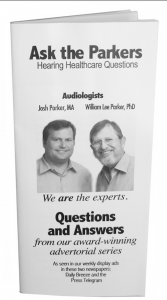Get Answers | FAQ
What is a hearing aid?
A hearing aid is a small electronic device worn in or behind your ear(s). This device has a microphone, and amplifier and filter circuits built into a tiny housing, plus a speaker (or receiver) that sends the improved louder sound to your ear drum.
How can hearing aids help?
Do I need a hearing aid?
If you have been told you need an aid or if you suspect you have a hearing loss, come see us at Parker Hearing Institute ASAP. We are the premier audiology practice in Southern California, and we have helped over 40,000 patients since 1975. On your first appointment we will consult with you, ask about your hearing challenges and lifestyle, and conduct a quick (and FREE) hearing screening to see how you track normal conversations. Assuming your ear canal is not plugged with wax (we check that too with a video otoscope) we will advise you. Maybe you don’t need hearing aids, in which case we send you home with a smile.
Do all hearing aids work the same?
The use of analog processing in hearing aids is virtually extinct today.
Digital aids convert soundwaves into numerical codes, similar to the binary code of a computer, before amplifying them. Virtually all the music you hear today has been digitized. In hearing aids, the aid can be specially programmed to amplify some frequencies more than others. Digital circuits gives a hearing professional more flexibility in programming the aid to a user’s needs and to certain listening environments. These aids also can be programmed to focus on sounds coming from a specific direction using tiny directional microphones built into housing.
Digital circuits are now amazingly complex, and hearing aids borrow from smart phone technology breakthroughs. A modern digital hearing aid is a tech marvel. The number of circuits combined, of course, impacts the price of the hearing aid. Quality digital aids are not cheap, despite what you may see and hear in advertisements.

Parker Hearing Institute – We’re Better Because WE Care!
Call today to schedule your appointment or learn more – (310)540-4327
What is a hearing aid?
A hearing aid is a small electronic device worn in or behind your ear(s). This device has a microphone, and amplifier and filter circuits built into a tiny housing, plus a speaker (or receiver) that sends the improved louder sound to your ear drum.
How can hearing aids help?
Do I need a hearing aid?
If you have been told you need an aid or if you suspect you have a hearing loss, come see us at Parker Hearing Institute ASAP. We are the premier audiology practice in Southern California, and we have helped over 40,000 patients since 1975. On your first appointment we will consult with you, ask about your hearing challenges and lifestyle, and conduct a quick (and FREE) hearing screening to see how you track normal conversations. Assuming your ear canal is not plugged with wax (we check that too with a video otoscope) we will advise you. Maybe you don’t need hearing aids, in which case we send you home with a smile.
Do all hearing aids work the same?
The use of analog processing in hearing aids is virtually extinct today.
Digital aids convert soundwaves into numerical codes, similar to the binary code of a computer, before amplifying them. Virtually all the music you hear today has been digitized. In hearing aids, the aid can be specially programmed to amplify some frequencies more than others. Digital circuits gives a hearing professional more flexibility in programming the aid to a user’s needs and to certain listening environments. These aids also can be programmed to focus on sounds coming from a specific direction using tiny directional microphones built into housing.
Digital circuits are now amazingly complex, and hearing aids borrow from smart phone technology breakthroughs. A modern digital hearing aid is a tech marvel. The number of circuits combined, of course, impacts the price of the hearing aid. Quality digital aids are not cheap, despite what you may see and hear in advertisements.

